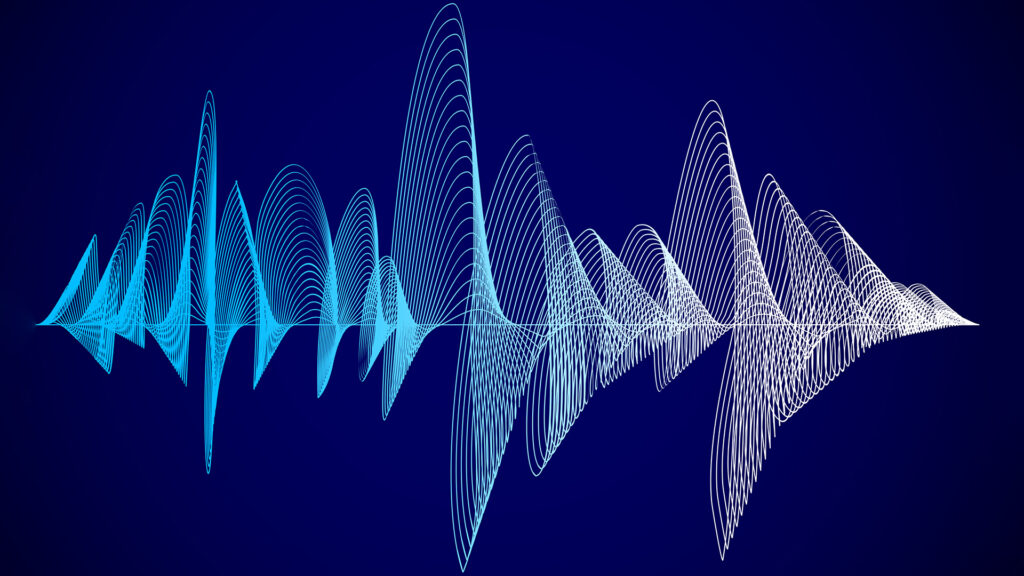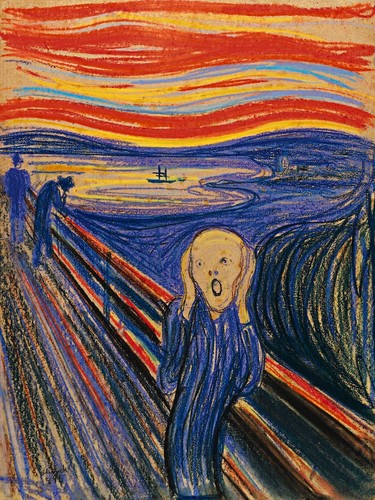The Sound Waves
Recognizing in advance that each class/group of students is different and has its own characteristics, we declare that all the following depend on the level of the class in terms of performance in the lesson, the degree of interest shown by the students, and the teamwork/cooperation that exists between students and between students and teachers. This means that these cases are always taken into account and adjusted accordingly in each case.
Course materials: 1. The famous painting by Edward Munch “The scream”.
2. A tape recorder on children’s cell phones that displays the
waveform of the voice when we tape something.
3. A bag of sand about half a kilo (sugar or rice could be used
instead of sand)
PHASE A- First Level of Approach
Teacher demonstrates the Edvard Munch painting: “The Scream”.
Short acquaintance with Edvard Munch. It can be done by the teacher but it can also occur after a little research from the students, at which point the presentation is made by them.
The painting “The scream” is presented in projection or in a conventional form on paper.
Beginning of the discussion: The teacher asks the first questions.
Possible Questions:
What do you see? What impresses you? What is dominant? What is at the center of the painting? What is the central issue?
(Possible answer: the human presence on the bridge is the dominant one)
In what condition is it? (Normal? Happy? Happy or dramatic?)
What conclusion do we draw looking at the painting?
{The answer will be dramatic (Naturally)}
What do you think are the dramatic emotions he expresses?
Possible answers: Fear, hopelessness? Despair? Call for help?
How are these feelings expressed by the protagonist?
(Possible answers: From the open mouth, the hands on the head, the deformed face in an extreme expression etc)
PHASE B - Second Level of Approach
All these exist and we see them in the painting. The painter managed to depict them. But, there are other elements that are not depicted in the painting and that nevertheless exist in the work of art. They are implied, as only art can imply things and meanings, through the sensitivity and imagination of both the creator and the viewer (who is also in a sense a creator who creates with his imagination and his sensitivity on each occasion the painting.)
Imagination and sensitivity are also elements with which we want to enrich the STEM fields.
In our example, such an element that does not exist but is not depicted is the voice that the central person makes as a result of his despair.
PHASE C - Third level approach - Action
If we were in the position of the person we see on the board and we had serious reasons to feel despair, hopelessness, pain, or to ask for help (in relation to the answers given by the children at a previous stage) what voice would we make?
Stage A.
Theatrical acting where children “play” these emotions and by playing / improvising they make such cries of despair and pain.
With mobile phones and the recording application, children record the cries of their improvisation.
Stage B
Children call for help shouting only one word, “Help”
With the mobile phones and the recording application, the children record the call and the “Help” that they shout.
Although they articulate the same word, the waveform in display on the mobile phone is different because of course each voice is different and has a different frequency.
(The results are not judged by artistic criteria in any case. On the contrary, all the versions and expressions of the children are correct and acceptable. Much more that they become the object and source of new stimuli to approach the object of the lesson.)
PHASE D - Observations and conclusions from the action
How is the sound transmitted from one source to another, from someone who emits a signal (pain, despair, etc.) to someone else who hears it and reacts (turns to see what is happening, rushes to help, etc.)?
Answer: it is transmitted by sound waves. These waves are transmitted circularly and have a wavy shape that if we depict it on paper, on the board or in projection we have again an artistic event (of minimal artistic value but an undoubted artistic event). The illustration also exists on children’s mobile phones.
If we look at the display of the wavy shape in the mobile application we will find that the wavy shape of the voice of each child separately, differs from student to student. Why?
Answer: Because within the frequency range of the human voice from about 20 Hz to 20,000 Hz, each of us has and uses different frequencies. The same happens concerning the range of frequencies that the human ear hears.)
The same goes for music and notes. We owe the infinite musical wealth we enjoy with any kind of music to this phenomenon whereas, the composer has to handle and combine only 8 notes.
PHASE E-FINAL CONCLUSION OF THE STEAM PROCESS
In our example, we started from an artistic event and passing through scientific landscapes we ended up in art again, while in the meantime we also created an artistic action with movement, voice and expression.
ADDITIONAL POSSIBILITIES that the teacher has, is to refer to and address other more specialized issues related to sound. These capabilities depend on the level of the class, teamwork and familiarity with the STEAM process.
During the lesson and on the occasion of the Munch painting, the teacher can raise many other sub-issues and talk about:
- The transverse and longitudinal sound waves
- The movement of air molecules on the occasion of a sound source (vocal chords in the case of the painting)
- The two basic values / characteristics of sound: in addition to the frequency we examined, we also have the volume. (Hypothesis game with children: Looking at the painting: What frequency would you say that the scream of the main character of the painting has? High or low? (high frequencies travel farther than low etc.)
- The units of sound: For Frequency there are HERTZ (Hz) and for volume there are Decibel (db) (Question: how many db can the scream be if we take into account that a simple conversation we have every day is 60 db and a motorbike that marches is about 100 db?)
- Shock waves (intensity waves above 194 db) where the air is extremely compressed
- Propagation of sound through a medium other than air (water or metal) with a molecular composition greater than air where then the sound exceeds 194 db
PHASE F - Closing of the course summary-evaluation
The class group can now discuss issues that rely on sound but also touch on other issues scientifically as well as historically, socially, etc.
- How sound waves hit the eardrum of our ear and are converted into electrical ones to go to the brain and be perceived by the person
- What about the supersonic speeds of airplanes
- Why do we lose our hearing permanently or temporarily when a pistol fires too close to our ear. (because it goes above 130 db)
- What about noise pollution in our daily lives
- The shock wave and how deadly it is in the case of the atomic bomb. (e.g. Nagasaki Hiroshima.)
PHASE G- Free artistic expression and creation
Each child spreads evenly on a flat surface, on the desk for example, the sand or sugar he has brought so as to create a smooth uniform surface.
The teacher asks the children to depict with one movement with their fingers the “Help” they previously shouted on the smooth surface of the sand.
What do we expect from this action?
A student maybe uses a finger to form a wavy shape.
Another student uses all the fingers of his hand to form 5 parallel lines.
A third student possibly can use a pencil or other sharp object makes a thin wavy line.
The aesthetic effect does not matter. What matters is the expression of the children, whatever it is.
Other possibilities of approaching scientific issues initiating by "The Scream" by Edward Munch
If the teacher focuses on the surrounding area then he will inevitably take into account the bright red colors. And he will talk about natural phenomena that go hand in hand with the explosion of a volcano. Phenomena such as atmospheric optics and the creation of polar stratospheric clouds that are created after the eruption of volcanoes and become visible during dusk and dawn. Consequently, he can also justify the artist who portrayed the sky and the atmosphere in this exact way. Besides, according to the history of the painting, it was created with devotion to the explosion of a volcano during which the materials and gases being hurled created such an atmosphere that made Munch paint it with red fiery colors.
The colors and the special style of the artist do not differ a lot from the natural phenomenon and thus it is proven that the distance between scientist and artist is not so great.
Auxiliary images




